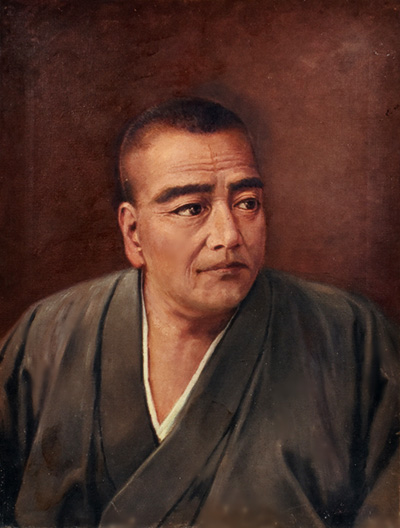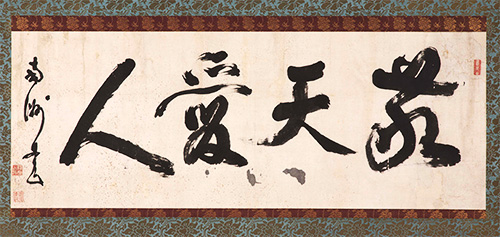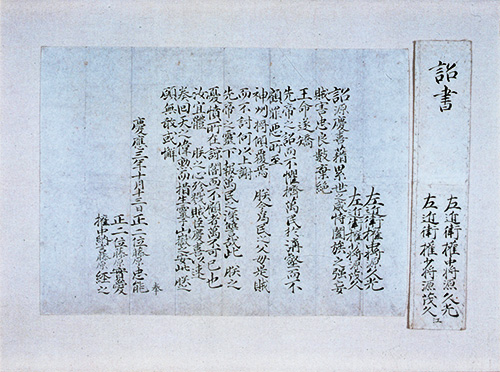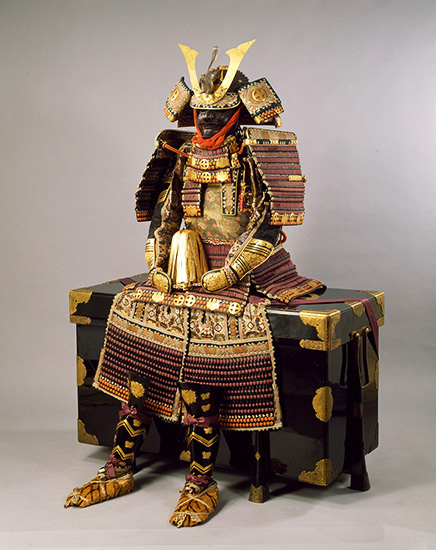
Portrait of Saigo Takamori by Ishikawa Shizumasa
Meiji period (19th century); owned privately and held in the Kagoshima Prefectural Museum of Culture REIMEIKAN
Ishikawa Shizumasa (1848–1925) was a samurai of the Shonai domain, and was also known as a painter. He traveled to Kagoshima in 1870 and 1875 where he met Saigo Takamori. While no photographs of Saigo Takamori exist today, there are a number of portraits of him remaining, many of which, however, were painted after his death. This portrait was painted by a painter who personally knew Saigo Takamori, and for this reason, it has special importance.

Keiten Aijin, calligraphy by Saigo Takamori
Held in the Kagoshima City Museum of Art
“Keiten aijin,” which means “respect the divine and love people,” are the words that Saigo Takamori often wrote in his calligraphy. He gave calligraphies with these words to others and endeavored to live by this motto himself. In his calligraphies, he used the name Nanshu, meaning “southern islands.” This name derived from his two banishments to islands in the south, and is known widely as his other name.
*This exhibit is shown between July 28 (Sat.) and August 20 (Mon.), 2018.

Secret imperial rescript to overthrow the Tokugawa shogunate
1867: Held in the Kagoshima Prefectural Museum of Culture REIMEIKAN (Tamazato Shimazu Family Collection)
This rescript was written based on an idea of Iwakura Tomomi who agreed with the anti-shogunate movement of Saigo Takamori, and was given to Okubo Toshimichi by Ogimachi Sanjo Sanenaru. This rescript ordered Shimazu Hisamitsu of the Satsuma domain and his son, Mochihisa (aka Tadayoshi) to overthrow the Tokugawa shogunate without delay. After being given a justified reason to attack the Tokugawa shogunate, the anti-shogunate group including Saigo Takamori went to fight in the Battle of Toba-Fushimi and then the Boshin Civil War.
*This exhibit is shown between August 22 (Wed.) and September 17 (Mon. and a national holiday), 2018.

Oyoroi armor owned by Shimazu Nariakira
Edo period (19th century); held in the Kyoto National Museum
This oyoroi armor is reported to have been owned by Shimazu Nariakira, a feudal lord of the Satsuma domain who promoted Saigo Takamori to an important position. Oyoroi is a type of samurai armor produced and used between the Heian period and the Kamakura period. This type of armor was originally designed to be worn by warriors on horseback, and gradually fell out of use with the shift of tactical importance from cavalry to infantry. In the Edo period, however, the popularity of oyoroi armor revived. This oyoroi armor includes the crests of the Shimazu family – kutsuwa jumonji (a cross in a circle) and goshichi no kiri (seven paulownia flowers in the center and five flowers on both sides) – in several places.

